by Winding Pathways | Jan 6, 2022 | Birds, Nature, Pests
Artful Dodgers
Walking one of Cedar Rapids’ trails sometimes is like a skier racing a slalom course. Instead of weaving between flags, pedestrians must dodge piles of goose poop.
It wasn’t always that way. Before the mid-1980s few geese lived in town. Cedar Rapids began restoring them. About 125 of the giant birds were released near downtown. Few predators pester them and are they prolific! A goose couple can live for decades and raise upwards of a dozen goslings a year. That is a lot of geese!
Geese Mixed Blessing
Canada geese are a blessing. We love hearing “goose music” as they wing over our house. Watching such attentive parents teach their babies to swim and find food is great fun.
Canada geese are a curse, mostly because there are so many of them and they enjoy living, and pooping, in town. Their droppings are more than a walking nuisance. Loaded with nitrates and bacteria, they stimulate algae growth, lowering water quality.
-
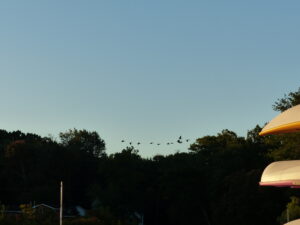
-
We enjoy the haunting call of geese on the wing.
-
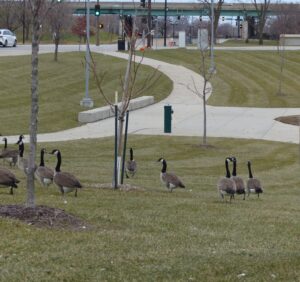
-
Geese love short grass
Geese Requirements
Geese love water but don’t need massive remote lakes. They prefer the dozens of small ponds at golf courses, corporate and school campuses, and parks. A lawnmower is a goose’s best friend. Well, maybe not a mower, but close-cropped lawns have tiny tender grass shoots that make fine goose dining. Running a mower down to a pond’s edge creates goose paradise. And problems for landowners.
People sometimes put snarling coyote mannequins near their pond to scare the big birds. It might work for a minute or two, but geese are smart. They figure out it’s a fake and nibble tender grass right under the phony predator.
How to Discourage Geese
Some cities reduce goose numbers by locating their nests, shaking the eggs to kill the embryos, which is called addling, or coating the eggs with oil so they won’t hatch. It may work to reduce flock size, but geese are protected by federal and state laws. Destroying eggs without a permit is illegal.
Legal Tricks
Here are less lethal and legal tricks that work, at least to some degree to discourage geese:
- Hold the chow. Folks love tossing stale bread to waterfowl, but it just encourages the crowding of the pesky birds.
- Stow the mower and let the grass grow. Geese shun tall grass. Even better, plant tall prairie grasses near the water’s edge.
- Fence ‘em out. For some reason geese don’t usually cross even small low barriers they could hop or fly over. A fence of lightweight plastic pipe set parallel to the edge of the water may discourage them from entering small areas.
We’ve got them. Geese are fellow city residents. We need to coexist, but a few simple tricks can discourage them from certain areas while still letting us enjoy delightful goose music as they wing overhead.
by Winding Pathways | Oct 7, 2021 | (Sub)Urban Homesteading, Chickens, Garden/Yard, Nature, Pests
There’s a Mouse in the House!
Sooner or later anyone who keeps a few chickens is likely to spot a mouse scurrying across the coop floor. Most sightings are after dark when hens are snoozing on their roosts. That’s when nocturnal mice seek a chicken feed dinner.
Commercial chicken feed is nutritious to more than chickens. Small rodents also thrive on it. They eat expensive feed and also foul it with their urine and droppings. Mice should be eliminated from the coop.
Two general types of mice can be found in places where both people and chickens live. European house mice are common all over the world. They usually spend their entire lives in a home or chicken house and rarely venture outdoors. These tiny rodents are dark gray all over. White-footed, or deer, mice are native rodents that commonly visit coops and the homes of the flock owner. They are easy to distinguish from house mice since, as their name implies, they have white feet and bellies.
While house mice live in a coop year round white-footed mice are more likely in cooler months. House mice usually eat food in place, while white footeds often carry seeds a distance and cache them in a hidden place to nibble on later. Find a pile of corn in an old boot or any other hidden place and the culprit is likely a white-footed mouse.
It’s not good to have either type of mouse mixing with chickens. Although it’s probably not possible to totally eliminate them, several actions greatly reduce their abundance.
The best strategy for reducing mouse infestations in either a house or chicken coop is to keep them out. Mice are tiny and athletic. They can squeeze through small holes and cracks, the same openings that let cold drafts enter. Keep both mice and cold air outside by filling in holes and cracks with caulking. The best time to do this is in early fall before cold weather settles in. Filling cracks also keeps box elder bugs, Asian beetles, and other insect pests outdoors. Cracks can be anywhere but are especially likely around window and door frames and where wires and pipes enter a structure.
Contain Food
Mice enter a chicken coop to find shelter from bad weather, safety from predators, and dinner. They love eating grain and chicken mash or pellets. Anything edible in the coop should be stored in metal containers with tight-fitting lids. Mice easily chew through plastic ones so avoid them. Use metal trash cans instead. Mice will help themselves to feed in a feeder, and most people leave feeders exposed at night. Since chickens don’t eat during dark hours put feeders in a tightly lidded metal garbage can overnight. This will keep mice away from them. The feeders can simply be put back where the chickens can access them the following morning.
Encourage Owls
A neighborhood owl family can be a chicken’s best friend. Owls love dining on mice. Great horned, barred, and screech owls are relatively common in suburban areas and patrol nighttime neighborhoods seeking small mammals to catch and eat. Owls are active when chickens are securely sleeping in the coop. This reduces the odds that a hen will end up an owl meal. According to Karla Bloem, Executive Director of the International Owl Center, owls can be a chicken keeper’s best friend.
Avoid Poison and Glue Boards
Although it’s tempting to use poison to rid a home or chicken coop of mice it should be avoided for these reasons:
- Poisoned mice might be eaten by chickens, non-targeted wildlife, and pets. They can be sickened or killed by residual poison in the mouse’s body.
- Poisoned mice sometimes die between walls or in inaccessible places. Soon their bodies smell terrible.
- Poison is slow acting and cruel. A quick death by a snapping trap is more humane.
- Chickens, children, pets, and nontarget wildlife might find and eat the poison.
Glue boards are pieces of cardboard or heavy paper covered with an extremely sticky substance. A mouse walking over a glue board will be held tightly. They can’t escape. While glue boards catch mice they also catch non-targeted animals. Any human who touches the sticky stuff will struggle to get free of it. Mice caught in glue boards usually starve to death or are found alive and struggling. It’s cruel.
Mice are relatively easy to trap using any of the many devices on the market. Most common are snap-type traps that have been effectively catching small rodents for over a century. For people who prefer not to touch a dead mouse, newer type traps enclose the entire body. Some traps are even electronic and electrocute the poor animal. There’s even a trap that will alert a cell phone when a mouse has been caught.

Place several traps side-by-side along a wall where you have seen evidence of mice.
Despite the fancy new type traps the old-fashioned kind, baited with peanut butter or soft cheese, is most common and least expensive. Traps should be set in places where chickens, pets, and children can’t access them. It’s best to set traps in the evening and either spring or retrieve them the next morning. Following are tips for increasing trapping success:
- Mice tend to run parallel to walls. Set traps next to walls with the trigger end closest to the wall. Traps with yellow plastic triggers that look like cheese may be slightly more effective than the older traps with metal triggers.
- Set traps in pairs or triplets. Put two or more traps side by side along the wall for the best odds of catching a fast-running mouse.
- Set out many traps. The best way to reduce mouse numbers is to catch all, or most, of the mice in the same evening.
- Don’t assume they’ve all been caught. Usually, there are many mice in a coop or home. Once most have been caught, keep setting them. Likely a few mice remain or new ones may enter.
Dispose of dead mice by flushing them down the toilet, putting them in the trash, burying them, or placing them in a woodsy or tall grassy area for scavengers to eat. Chickens will eat mice, also. Wash your hands well after touching the traps or mice.
Reducing mouse numbers in a coop is an important part of chicken husbandry. It takes some effort but preventing an infestation and trapping any that lurk in the coop is important.
*Reprinted with permission from Hoover’s Hatchery.
by Winding Pathways | Sep 30, 2021 | Garden/Yard, Nature, Pests
Poison ivy is a universally disliked and feared plant. It seems to grow everywhere. Encounter it and risk an itchy rash…..or worse. Some people are so sensitive to the oil on the leaf’s surface that they end up hospitalized.
Despite the discomfort it causes, poison ivy is an amazing native plant. It’s tough and thrives in any soil type, in drought or deluges. It loves living in the woods, at the edge of lawns and ballfields, and even in city vacant lots. It grows along ocean beaches and up mountains.
Scratching people may disagree, but there are two things to love about poison ivy. Both happen in the fall.

Keep your distance from this beguiling, colorful plant.
As days become cooler and daylight shortens poison ivy is one of the first plants to turn color. A month before sugar maples color up poison ivy leaves turn a glorious deep red. By late fall birds enjoy eating plentiful poison ivy berries. Apparently, they don’t get the itch and happily spread the common plant’s seeds when they poop them out.
There is one certain way to prevent a poison ivy itch. Enjoy it from a distance. Only contact with the plant’s oil can cause a rash. This can happen by touching the plant leaves or vines, patting an animal that has run through a poison ivy patch, accidentally touching clothes that have rubbed by poison ivy, or by breathing smoke with the oils in it when an area is being burned has poison ivy in it.
by Winding Pathways | Sep 9, 2021 | Garden/Yard, Nature, Pests, Trees/Shrubs
We’ve got a peach problem.
Iowa’s frigid winters don’t favor peach trees, but we’ve got a tough one in the front yard that’s withstood temps down to 30 below zero. Each May it graces our yard with pink blossoms that transform into smallish, tasty peaches that ripen around Labor Day.
We love peaches. So do deer. That means that every fall we play a waiting game with them.
Peaches look ripe a few weeks before they truly soften and ripen. When they’re hard as stones they don’t taste good. We know it. So do the deer. This starts the tricky part.
When will they be ready to pick? If we don’t harvest them at just the right time the deer will do it for us. They’ll devour every single one the night before we intend to pick. This year we ran a wide circle of wire mesh around our tree, but we know hungry deer will figure out how to foil it.
-

-
Each spring the fragrant pink blossoms grace our yard.
-
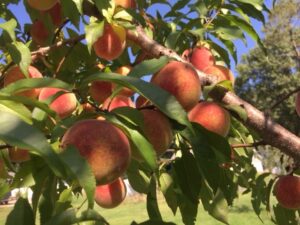
-
Deer sense when peaches are ready to eat.
As we write this on September 2nd our peaches are still hard. The deer are watching and waiting. We know because we found fresh scat just outside the wire fencing last night. We’ll let our readers know who gets the harvest.
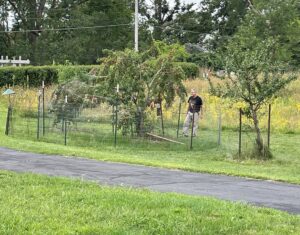
Adding extra fencing and stakes may keep the deer back.
by Winding Pathways | Jun 17, 2021 | (Sub)Urban Homesteading, Pests
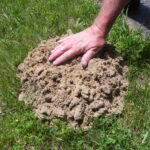
Moles sometimes push up excess dirt.
It’s that season again. Recently we spotted a symmetric dirt cone poking up in our lawn. Fortunately, it wasn’t an early-stage volcano about to erupt. Rather, a mole pushed dirt out of the way so it could continue tunneling.
People hate moles for forming similar dirt piles and their humped tunnels that lawnmower blades sometimes catch. Here’s some basic mole information to help change perspective from a “problem” to a resource and “radical welcoming”.
A Mole Primer
Moles are small mammals of several species that live across North America, Asia, and Europe. They make their living tunneling through the earth to find earthworms and other invertebrates to eat. Contrary to popular belief moles don’t eat plants or roots. They make two types of tunnels. One is fairly deep and is a mole’s highway. It’s for transportation. The other is the familiar humped tunnel moles create to find food that usually is just below the soil surface. Every once in a while, a tunneling mole needs to get rid of some dirt, so they push it to the surface, creating a molehill.
Mole or Gopher?
People confuse moles with gophers. Both are small tunneling animals, but they are very different in these ways:
- Moles eat invertebrates, not plants. Gophers eat plants and roots.
- Moles are most common in moist shady soil and suburban yards. Gophers are more common in open sunny areas, like pastures, and rarely enter suburbia.
- Moles create symmetric hills of dirt. Gophers make elliptical-shaped mounds.
- Mole populations are usually small, while there may be many gophers living in an area.
By softening and aerating the soil both types of animals promote long-term soil health. Often an area bordering a mole tunnel will have the greenest grass in the lawn, for example.
Killing Moles
Mole dislike is so intense that many people work hard to kill any that dare tunnel in their yard. Here are two common mole weapons and why we don’t use them:
- Plunge-type traps impale a hapless mole. We worry that a neighborhood child or someone’s pet could be speared by one of these traps, which also are cruel.
- Poison peanuts are sold in garden stores. The package may say the peanuts will kill moles……and they will if you can get a mole to eat one, but remember that moles eat worms and insects, not peanuts or plants. A peanut is a plant. So people who buy poisoned peanuts are wasting their money and poisoning critters that may eat the poisoned peanut. Like a favorite, curious dog.
What We Do with Moles at Winding Pathways
We view our moles as another interesting and beneficial animal that shares our yard. Yup, mole tunnels kill a strip of grass in the short term, but in the long term, mole activity improves the soil. Worms and most other invertebrates contribute to soil health, so we know if we have moles, we have a healthy lawn.
What to Do About Moles
There are two ways to deal with moles. First, a homeowner can set traps and poison and attempt to kill beneficial animals. Second, forget trying to “get rid” of moles. Instead, just tamp down their tunnels before mowing, and don’t worry about them.
We follow the second.
by Winding Pathways | Mar 11, 2021 | (Sub)Urban Homesteading, Birds, Pests
Millions of people love their cats. Some 36% of households keep an average of two cats. They are the second most popular companion animal in the United States, lagging only behind dogs.

Cats decimate bird populations.
Some cats cause problems, especially when owners allow them to free-range the neighborhood. According to the American Bird Conservancy, they kill 2.4 billion birds a year and may be a significant cause of the decline of many species.
Catios to the rescue!
A growing number of cat lovers, many who also enjoy bird watching, recognize the problem and are increasingly adding a catio to their home. Wonder what it is???? It’s simply an enclosure that allows the family cats to enjoy fresh air, sunshine, and a bit of adventure without allowing them complete access to the neighborhood.
Many catios are enclosed patios, which spawned the name, that let cats play outdoors while their owners enjoy lounging or socializing nearby. They are relaxing places for both species. Other catios are small and positioned outside windows. Catios can be either purchased or homemade and often an existing patio can be modified into one.
Safety First!
Although cats love roaming the neighborhood, it is not a safe place. They pick up ticks and transfer them to humans, suffer accidents, are killed by cars as they cross streets, and are taken by predators.
A catio is a good solution to several problems. It allows cats to enjoy the outdoors safe from cars and predators in a place where they can’t kill birds. And, the owners always know where their cat is.
Harmony
An array of catio photos is visible on Catio Spaces. Many other websites feature them. Catios are a great way for cat lovers to show care of wildlife species, keep their cats safe, and live in peace with human neighbors who are frustrated when they spot a feline stalking birds under their feeder.









